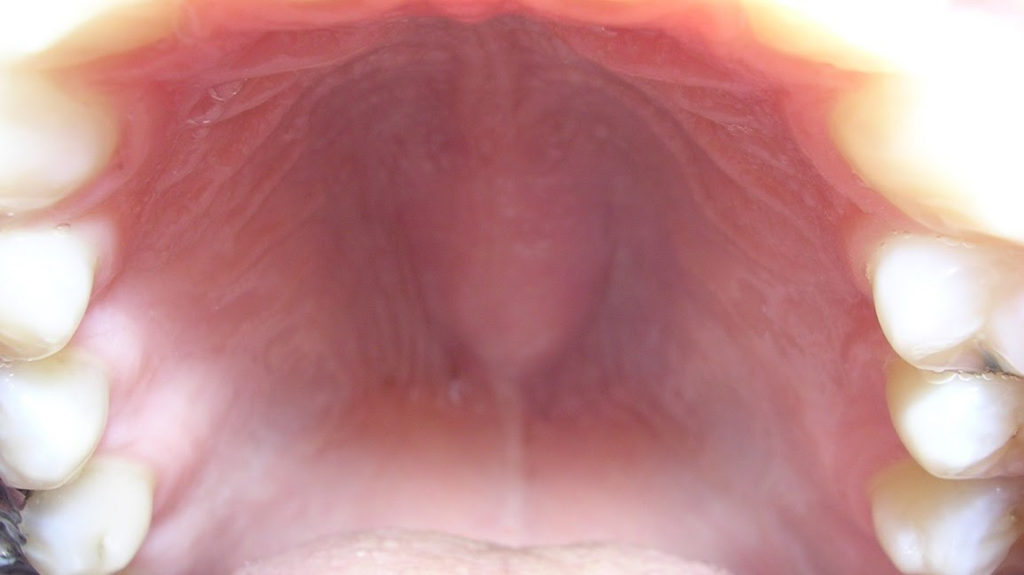A torus palatinus is a bony growth that develops on the roof of the mouth. These growths come in many different shapes, and they may be very small or quite large.
A torus palatinus is not cancerous or harmful. However, because serious medical conditions can cause similar growths, it is important to have a doctor check any changes in the mouth.
In this article, learn more about tori palatini, including the causes, symptoms, and treatment options.
Pictures

Symptoms
The hard palate, or roof, of the mouth is slightly rounded and usually smooth. However, some people may have a hard lump or protrusion extending out of this area.
This lump, called a torus palatinus, may develop over time. In other cases, a person may have it their entire life.
Some symptoms a person might notice if they have a torus palatinus include:
one or more hard lumps at the top of the mouth
painless bumps at the top of the mouth
difficulty getting orthodontic devices or mouth guards to fit correctly
a speech impediment or a change in speech patterns, if the growths are large
difficulty fitting dentures on the roof of mouth
difficulty chewing, if the growths are new, large, or located near teeth
difficulty swallowing
food getting stuck around the growths
Some signs and symptoms that the growths might be something other than a torus palatinus include:
the presence of other symptoms, such as fever or swelling
ulcers on the gums
the presence of growths elsewhere on the body
feeling ill or noticing other unexplained symptoms
the growths becoming painful
symptoms of tooth decay, such as broken teeth, tooth pain, or very swollen gums
Causes
Tori palatini are common, affecting around 20–30% of people in the United States. They appear to be more common in women and in people of Asian or Inuit descent.
However, doctors do not understand what causes them or why they are more common in some groups than in others.
Some potential causes and risk factors might include:
Age: The growths are more common in people over the age of 30.
Mouth shape and bite structure: The shape of a person’s mouth, tooth crowding, and other factors might increase the risk.
Genetics: A 2015 study of twins suggests a strong genetic link for bony outgrowths in the mouth, even in those who have other risk factors.
Tooth grinding: People who grind their teeth may be more likely to experience these bony growths.
Bone mineral density: Changes in bone mineral density may cause a torus palatinus. A few older studies suggest that older adults with a torus palatinus have higher bone mineral density than their peers.
Treatments
Tori palatini are usually harmless. They will not usually require treatment unless they interfere with a person’s speech, ability to swallow, or daily life.
However, removal may be necessary before the fabrication of a denture. In that case, a dentist may recommend surgery to remove the growth or changing the shape of the dental device to fit around the growth.
Several other medical conditions may also cause swollen growths in the mouth, including in the hard palate. These include:
a dental abscess, which may cause swelling or a cyst on or near an infected tooth
oral cancer, which can cause unusual growths on the palate or in the throat
a cyst in the mouth
injury to the mouth from sharp or hot food, dental appliances, tooth grinding, or trauma such as a blow to the mouth
an infected wound in the mouth
Complications
Tori palatini are not dangerous. The growths do not cause cancer, infections, or other serious complications. However, like any growth in the body, it can interfere with normal functioning.
Very large growths and those located near other structures are more likely to cause complications. Some common issues include:
Discomfort in the mouth: A person may find that the growth interferes with the normal positioning of their tongue or makes it difficult to close or rest the mouth comfortably.
Swallowing: Depending on the location of the growth, a person may have difficulty swallowing.
Eating and chewing: Food may get stuck on the growth or make it difficult to swallow.
Oral hygiene: Sometimes, the growth may make it difficult to brush the teeth effectively. When food gets stuck on the growth, it can cause oral health issues such as bad breath and tooth decay.
Speech issues: Occasionally, the growth may make it difficult to correctly move the tongue and mouth when speaking. This can cause a person to develop speech issues such as a lisp.
Anxiety: Some people are self-conscious about the growth. Others may feel afraid that it will become cancerous, especially if they keep developing new growths.
When to see a doctor
A person should see a doctor or dentist for any unusual growths in the mouth. Even if it looks like a torus palatinus, it is important to rule out other potential causes.
People with a history of tori palatini should see a doctor if:
they notice new growths
the growths become painful
the growths cause new symptoms, such as difficulty swallowing or talking
the growths do not disappear in a few weeks
the growths change in size or color
they develop other symptoms, such as bleeding from the growths, mouth pain, bad breath, broken teeth, or other oral health issues
Outlook
Developing a torus palatinus can potentially be alarming, especially to someone anxious about oral health or cancer. However, these growths are benign, which means that they do not cause cancer and are not a risk factor for cancer.
As long as they do not cause significant symptoms, a person does not need to treat them.
However, because new growths in the mouth could warn of a more serious health concern, it is important to consult a doctor rather than self-diagnose.

Leave a Reply